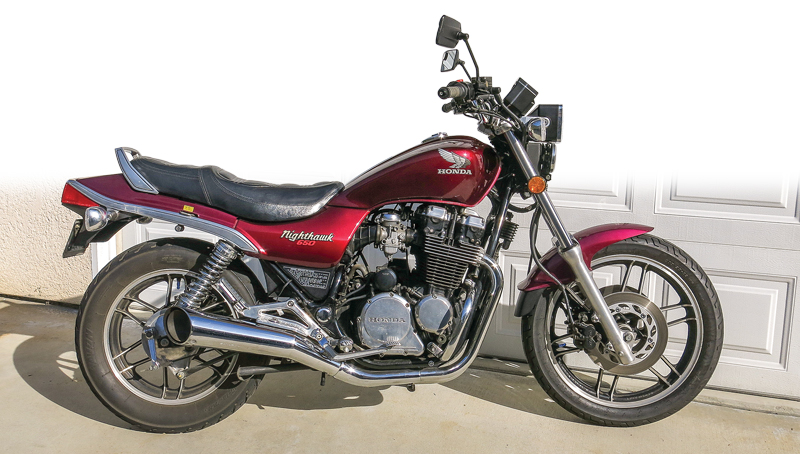These are the known mechanical and performance specifications for your 1983 Honda CB 650 SC Nighthawk.
Basic Specs

Engine
Displacement655.00 ccm (39.97 cubic inches)
Type
DetailsIn-line four, four-stroke
Max RPM10000
Compression9.5:1
Bore/Stroke60.0 x 58.0 mm (2.4 x 2.3 inches)
Valves/Cylinder4
FuelingCarburettor. Honda says 32mm; technically they are Keihin 29mm
IgnitionSolid state
Exhaust4-2 double muffler
Lubricationwet sump
CoolingOil & air
Drivetrain
Gearbox6-speed
Final DriveShaft drive (cardan)
Clutchwet, multi-plate clutch actuates hydraulically
Driveline
Fuel Economy & Polution
Fuel Consumption5.88 litres/100 km (17.0 km/l or 40.00 mpg)
Fuel Capacity12.86 litres (3.40 gallons)
Emissions136.4 CO2 g/km. (CO2 - Carbon dioxide emission)
Chassis
Frame Type
Rake
Trail
Front SuspensionAir-adjustable, leading-axle forks with dual Syntallic bushings
Front Travel39 mm (1.5 inches)
Rear Suspensiontwo VHD shocks with four-way adjustable damping
Rear Travel
Seat
Seat Height790 mm (31.1 inches) If adjustable, lowest setting.
Alt. Seat Height
Total Height
Total Length
Total Width
Ground Clearance
Wheelbase1,461 mm (57.5 inches)
Dry Weight197.0 kg (434.3 pounds)
Wet Weight
Wheels & Brakes
Front Tire/Tyre100/90-19
Rear Tire/Tyre130/90-16
Front BrakesDouble disc. (2) 2- piston calipers, with TRAC system
Front Brake Diameter
Rear BrakesExpanding brake (drum brake). single-leading-shoe rear brake
Rear Brake Diameter40 mm (1.6 inches)
Wheels



Comments
Without doubt the new CB650´s most impressive features are its valve-lash adjustment and its low-maintenance design. Honda engineers seemto have removed the last tedious, time-consuming ritual from motorcycling´s Saturday afternoon Here is a machine that fulfills the 650 promise: it feels small, smaller than a 750, yet runs with 750s without even breathing hard. Its smoothness and comfort invite long rides. The rear suspension´s springing and damping rates do need tuning to provide a more supple ride; and for sporting riders, Honda´s engineering department should attend to the drive line´s irksome lash and shaft reaction. Having a motorcycle that needs barely more maintenance than a safetypin is a bargain only if its owner genuinely enjoys the way the motorcycle works. Diehards may complain sourly about ´appliance-like´ character, but few riders will quarrel with the way this motorcycle functions. For about six or seven years, first one manufacturer and then another has proclaimed that its 650s perform like 750s; certainly there´s been much sound to this proclamation but little real 750 fury. Now the 650 Nighthawk delivers. Everyone who has ridden the 650 Nighthawk has come back impressed. This 650 is the new measuring standard of the 40-inch class. And the standard has just been raised. A lot.